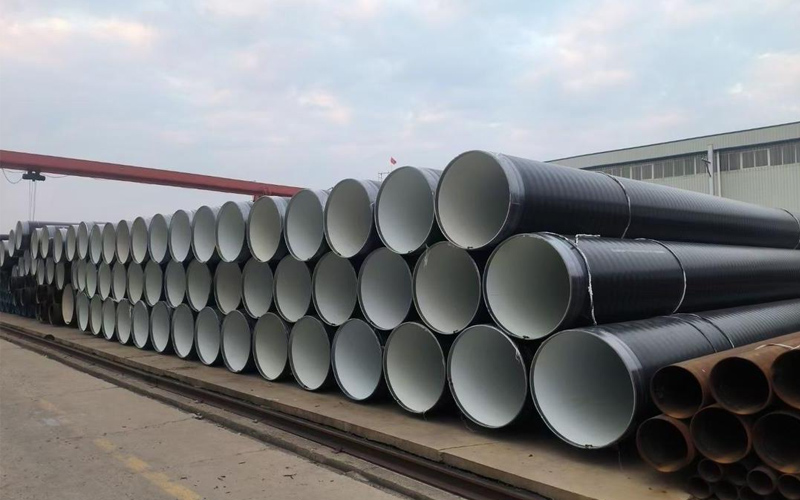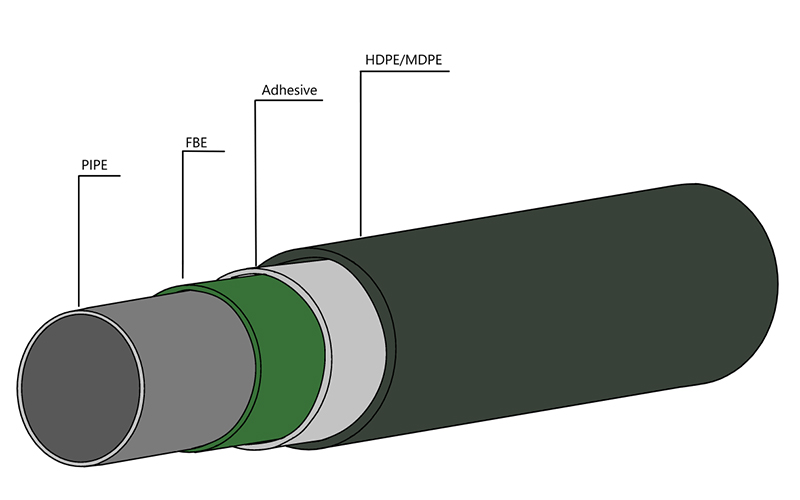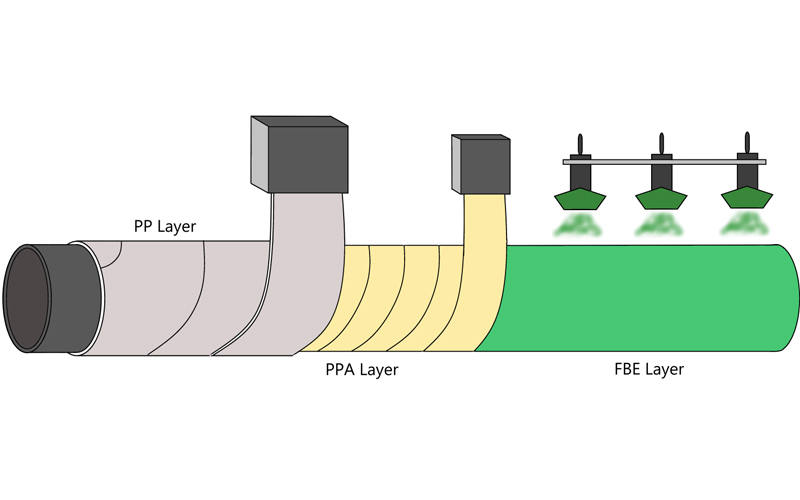FBE steel pipe: the technological armor of the steel defense line
I In the icy waters beneath the Norwegian Sea pipeline, a section of FBE Lined Carbon Steel Pipe has been in service for 25 years. When we inspected and dismantled, the coating’s integrity rate remained over 95%, and the deep-sea shellfish on this surface were easily to removed, revealing the smooth FBE coating beneath. This deep green protective layer marks that a milestone in modern industrial steel corrosion protection technology.This kind of technique is being used all over the world.
Coating material and production: molecular level steel armor
FBE (welded epoxy powder) is not a common coating, but a dense polymer protective layer formed by electrostatic spraying + high temperature curing:
Molecular level adhesion: the surface of steel pipe is sandblasted to Sa2.5 grade (roughness 75μm), and then heated to 230℃, epoxy powder melts and flows, forming chemical bonds with the matrix, and the bonding strength is>70MPa.
Multi-layer defense architecture: take FBE Coated Steel Pipe as an example, its standard structure is:
Carbon steel substrate → chemical conversion layer → 300μm FBE main protection
Smart factory production: Modern steel pipe factory adopts fully automatic assembly line, and the process from rust removal to coating curing is completed in a closed environment (such as the production line speed of EEW in Germany reaches 3m/min), ensuring that the thickness deviation of epoxy coated steel pipe is less than ±10%.
Production process:
FBE steel pipe production begins with strict surface treatment, through sandblasting and rust removal to achieve the required cleanliness and anchor depth of the steel pipe. After preheating, the epoxy powder is evenly coated on the surface of the pipe body by electrostatic spraying process. The powder melts and levels when heated to form a continuous coating, and then enters the curing stage, completing the cross-linking reaction at a specific temperature to form a tough anti-corrosion layer. Finally, water cooling and quality inspections are performed, including thickness, continuity (EDM leak detection) and adhesion tests.
Key Considerations:
Surface treatment: Oil, rust and impurities must be thoroughly removed, and the depth of the anchor grain must match the powder requirements, otherwise adhesion will be affected.
Temperature and humidity control: The preheating temperature, the temperature and humidity of the spraying environment and the temperature of the curing oven need to be accurately controlled to ensure that the powder is leveled and cured sufficiently, and to avoid pinholes, orange peel or poor curing.
Powder quality and spraying: The powder needs to be kept dry, sprayed evenly and the thickness is up to standard.
Curing management: Sufficient curing time and temperature must be guaranteed for the coating to be fully cross-linked for optimal performance.
Full protection: Prevent damage to the coating during handling, cooling, and inspection. Strict quality inspection is the key to ensuring the corrosion resistance of the final product.
Special variants expand the boundaries of applications:
FBE coated stainless steel pipe : FBE layer is superimposed on 316L stainless steel substrate to deal with strong corrosion and high temperature scenarios (such as chemical reactor);
FBE Lined Carbon Steel Pipe: the inner wall of the pipe is coated with a thick layer of 500μm to resist fluid erosion (the life of the coal mine drainage pipe is increased by 8 times).
Coated VS un-coated steel pipe: performance life and death situation
Corrosion resistance
| Corrosion type | Un-coated steel pipe | FBE coated steel pipe |
| Soil corrosion | 2 perforations (saline-alkali land) | > 30 years without failure (actual measurement) |
| Sea water intrusion | The average annual corrosion rate is 1.5mm | <0.03mm/year (cathodic protection synergy) |
| Acid medium | Six months of surface ulcers | The FBE lined carbon steel pipe is resistant to pH=2 strong acid |
Mechanics and economic benefits
Impact resistance: FBE coating with toughness of 100J/m (ASTM G14 standard) to resist impact from gravel during transportation and installation;
Friction coefficient: the friction coefficient of coating surface is only 0.08, reducing the energy consumption of fluid transportation by 12%;
Full cycle cost: although the initial cost increases by 40%, but the frequent replacement (no coating tube is replaced every 5 years) is eliminated, and the 30-year cycle cost decreases by 60%.
Engineering case: Saudi crude oil pipeline uses carbon steel pipe FBE coated. In the high temperature and high sulfur environment of 70℃, the maintenance frequency is reduced by 83% compared with un-coated pipe.
Application scenario: steel guards on the battlefield of corrosion
1. Lifeline of energy transmission
Oil pipeline: 90% of the world’s onshore oil pipelines use FBE coated steel pipe , and the FBE coated stainless steel pipe in the Arctic Circle project can withstand-50℃ extreme cold;
Submarine cable sheath: double coating structure (FBE+ polyethylene) to resist 15MPa water pressure and microbial corrosion.
2. Buildings and infrastructure
Steel frame: In the steel pipe frame , FBE coated steel pipe is used as the key load-bearing member to avoid structural force attenuation caused by corrosion (the core support of Burj Al Arab has been in service for 25 years);
Bridge cable: The cable is embedded with FBE coated steel pipe to strengthen the core, and the tensile strength retention rate is more than 99%.
3. Special industrial scenarios
| Domain | Solution | Core advantage |
| Chemical storage and transportation | FBE lined carbon steel pipe | Resistant to hydrofluoric acid/concentrated alkali, no rubber lining maintenance |
| mine drainage | Thickened FBE coated steel pipe (FBE Pipe) | Abrasive particle flushing (still applicable for 40% mortar content) |
| Geothermal well pipe | FBE coated stainless steel pipe + high temperature curing process | Tolerant to 150℃ geothermal water |
Conclusion: FBE coating – the second life of steel pipes
From the intelligent production line of steel pipe factory to the energy artery across the desert, FBE coated steel pipe reshapes the application of steel with triple technological value:
Protection revolution: molecular level adhesion of epoxy coated steel pipe, the life of steel pipe from “years” to “centuries”;
Scene breakthrough: FBE coated stainless steel pipe has overcome the polar/deep sea restricted area, and FBE lined carbon steel pipe can pass through acid and alkali media
Supply ecology: Global FBE coated pipe suppliers have formed a graded certification system (such as ISO 21809-2) to ensure the supply chain security of major projects.
In the future, with the implementation of new technologies such as nano-modified FBE (thermal conductivity increased by 300%), this steel armor will be thinner, stronger and smarter, continuing to defend the steel veins of human industrial civilization.
Get Your Custom Steel Pipe Quote Today!
Provide us with your project details (like application, specifications, quantity). Our experienced team will respond with a tailored solution and competitive quote within 24 business hours.
Related Articles
ASTM A53 vs. API 5L: A Guide to Selection and Application
Introduction:Technology differences determine success or failure, and selection needs to be “precise”
Steel Density Analysis: Core Differences between Mild and Medium Carbon Steels and Industrial Applications
3LPE coated steel pipe: a solid barrier in the field of industrial corrosion protection
3LPP coated pipe: anti-corrosion guard in high temperature and high pressure environment
How LSAW/SSAW Steel Pipes Ensure Safe & Durable Drinking Water Pipelines
HOT TAGS
latest posts
- 3LPE coated steel pipe: a solid barrier in the field of industrial corrosion protection
- Breakthrough of spiral welded pipe technology: How does SSAW steel pipe conquer the water supply project in rugged mountain areas of South America?
- What is offshore pipeline and its Applications in offshore oil and gas development
- 3PP Coating for High-Temp Pipe Corrosion | Case Study
- A Guide to ISO 21809: 3LPE & FBE Pipe Coating Standards














